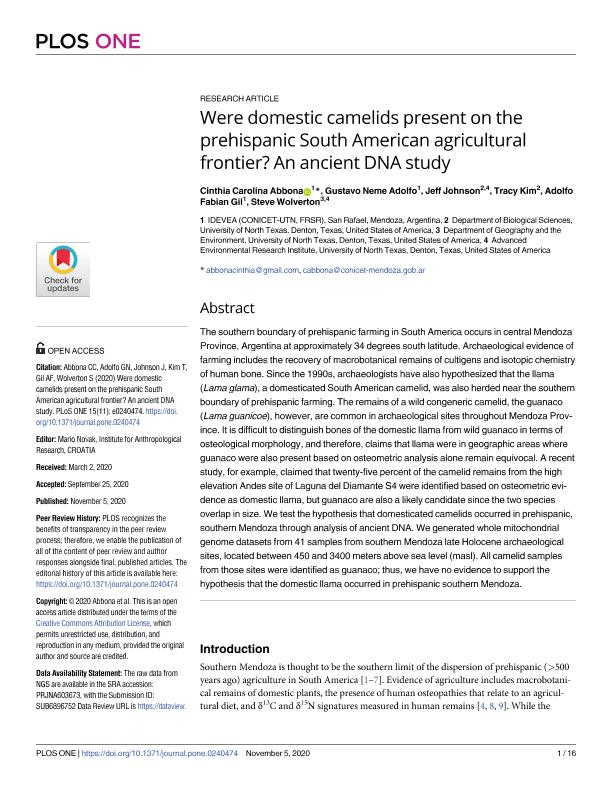Mostrar el registro sencillo del ítem
dc.contributor.author
Abbona, Cinthia Carolina

dc.contributor.author
Neme, Gustavo Adolfo

dc.contributor.author
Johnson, Jeff

dc.contributor.author
Kim, Tracy
dc.contributor.author
Gil, Adolfo Fabian

dc.contributor.author
Wolverton, Steve
dc.date.available
2021-10-15T18:56:10Z
dc.date.issued
2020-11-05
dc.identifier.citation
Abbona, Cinthia Carolina; Neme, Gustavo Adolfo; Johnson, Jeff; Kim, Tracy; Gil, Adolfo Fabian; et al.; Were domestic camelids present on the prehispanic South American agricultural frontier? An ancient DNA study; Public Library of Science; Plos One; 15; 11; 5-11-2020; 1-16
dc.identifier.issn
1932-6203
dc.identifier.uri
http://hdl.handle.net/11336/143930
dc.description.abstract
The southern boundary of prehispanic farming in South America occurs in central Mendoza Province, Argentina at approximately 34 degrees south latitude. Archaeological evidence of farming includes the recovery of macrobotanical remains of cultigens and isotopic chemistry of human bone. Since the 1990s, archaeologists have also hypothesized that the llama (Lama glama), a domesticated South American camelid, was also herded near the southern boundary of prehispanic farming. The remains of a wild congeneric camelid, the guanaco (Lama guanicoe), however, are common in archaeological sites throughout Mendoza Province. It is difficult to distinguish bones of the domestic llama from wild guanaco in terms of osteological morphology, and therefore, claims that llama were in geographic areas where guanaco were also present based on osteometric analysis alone remain equivocal. A recent study, for example, claimed that twenty-five percent of the camelid remains from the high elevation Andes site of Laguna del Diamante S4 were identified based on osteometric evidence as domestic llama, but guanaco are also a likely candidate since the two species overlap in size. We test the hypothesis that domesticated camelids occurred in prehispanic, southern Mendoza through analysis of ancient DNA. We generated whole mitochondrial genome datasets from 41 samples from southern Mendoza late Holocene archaeological sites, located between 450 and 3400 meters above sea level (masl). All camelid samples from those sites were identified as guanaco; thus, we have no evidence to support the hypothesis that the domestic llama occurred in prehispanic southern Mendoza.
dc.format
application/pdf
dc.language.iso
eng
dc.publisher
Public Library of Science

dc.rights
info:eu-repo/semantics/openAccess
dc.rights.uri
https://creativecommons.org/licenses/by-nc-sa/2.5/ar/
dc.subject
Domestication
dc.subject
Ancient DNA
dc.subject
Lama glama
dc.subject
Lama guanicoe
dc.subject
Sur de Mendoza
dc.subject
Holoceno tardío
dc.subject.classification
Arqueología

dc.subject.classification
Historia y Arqueología

dc.subject.classification
HUMANIDADES

dc.title
Were domestic camelids present on the prehispanic South American agricultural frontier? An ancient DNA study
dc.type
info:eu-repo/semantics/article
dc.type
info:ar-repo/semantics/artículo
dc.type
info:eu-repo/semantics/publishedVersion
dc.date.updated
2021-09-06T19:59:02Z
dc.journal.volume
15
dc.journal.number
11
dc.journal.pagination
1-16
dc.journal.pais
Estados Unidos

dc.journal.ciudad
San Francisco
dc.description.fil
Fil: Abbona, Cinthia Carolina. Universidad Tecnologica Nacional. Facultad Reg.san Rafael. Instituto de Evolucion, Ecologia Historica y Ambiente. - Consejo Nacional de Investigaciones Cientificas y Tecnicas. Centro Cientifico Tecnologico Conicet - Mendoza. Instituto de Evolucion, Ecologia Historica y Ambiente.; Argentina
dc.description.fil
Fil: Neme, Gustavo Adolfo. Universidad Tecnologica Nacional. Facultad Reg.san Rafael. Instituto de Evolucion, Ecologia Historica y Ambiente. - Consejo Nacional de Investigaciones Cientificas y Tecnicas. Centro Cientifico Tecnologico Conicet - Mendoza. Instituto de Evolucion, Ecologia Historica y Ambiente.; Argentina
dc.description.fil
Fil: Johnson, Jeff. University of North Texas; Estados Unidos
dc.description.fil
Fil: Kim, Tracy. University of North Texas; Estados Unidos
dc.description.fil
Fil: Gil, Adolfo Fabian. Universidad Tecnologica Nacional. Facultad Reg.san Rafael. Instituto de Evolucion, Ecologia Historica y Ambiente. - Consejo Nacional de Investigaciones Cientificas y Tecnicas. Centro Cientifico Tecnologico Conicet - Mendoza. Instituto de Evolucion, Ecologia Historica y Ambiente.; Argentina
dc.description.fil
Fil: Wolverton, Steve. University of North Texas; Estados Unidos
dc.journal.title
Plos One

dc.relation.alternativeid
info:eu-repo/semantics/altIdentifier/url/https://dx.plos.org/10.1371/journal.pone.0240474
dc.relation.alternativeid
info:eu-repo/semantics/altIdentifier/doi/http://dx.doi.org/10.1371/journal.pone.0240474
Archivos asociados
